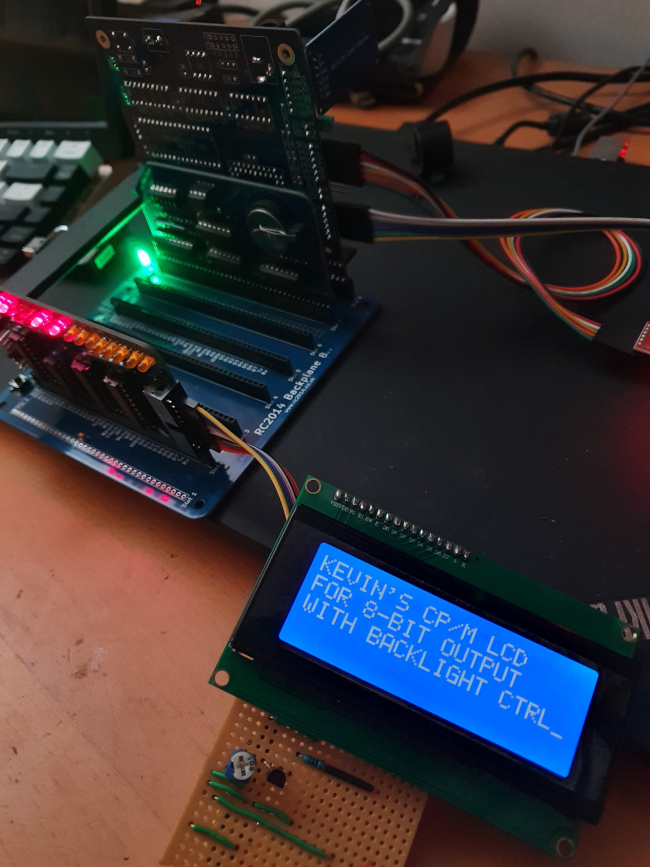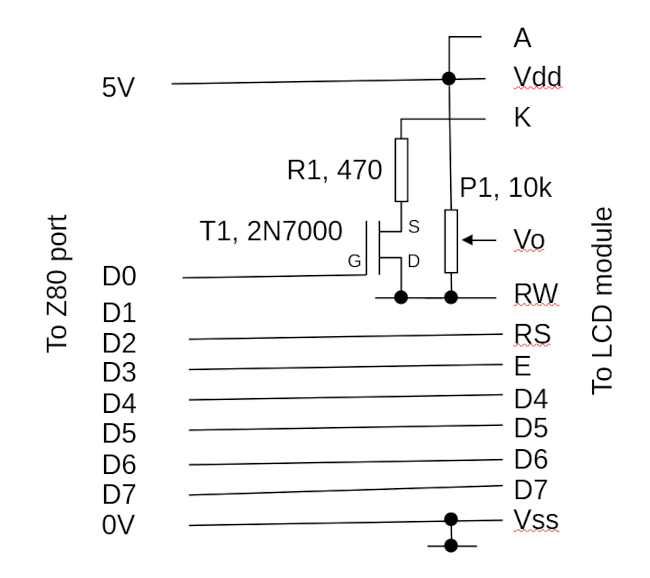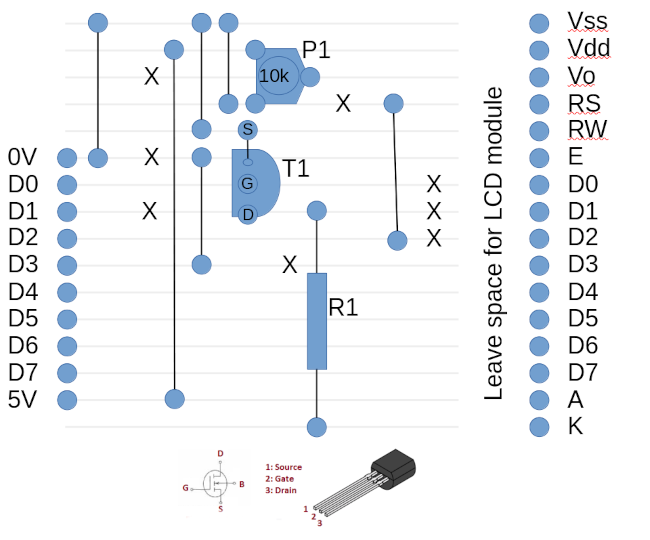Version 0.1a
cpmlcd is an assembly-language library for CP/M (Z80), for displaying
text on the popular HD44780 LCD module. It uses 4-bit data transfers, so
only seven digital output lines are needed (the 4 data lines, enable (clock),
register select, and backlight control). The backlight is expected
to be controlled by a circuit external to the LCD module (see below),
but this controller can be omitted, and the backlight just connected
to the 5V supply, leaving it permanently on. Leaving the backlight
permanently off isn't really an option other than in very bright
ambient light.
Here is the LCD module and control circuit in use with a RC2014-based CP/M system.
The library should work with LCD modules of up to 4x64 characters, but 4x20 is the largest routinely available, and the largest I have tested.
The utility lcd.com is a test driver for the library. It just
sends text specified on the CP/M command line to the LCD, starting in
the top-left corner. A number of escape characters can be
used to generate control characters, as the library supports
the handling of some of these. The text will wrap around lines when
it's too long to find on one line.
As is common when interfacing this LCD module, the driver only writes data, so it cannot query the LCD to find when an operation is complete. This means that we have to insert time delays between operations. Although rather inelegant, this does mean that we can use a simple 8-bit output port for the control. I have been testing using the SC129 digital I/O module designed by Stephen Cousins, and documented here:
https://smallcomputercentral.com/sc129-digital-i-o-rc2014/
A more sophisticated digital I/O module, such as one based on an 8255 chip, would also work; but custom initialization code would have to be added to set the I/O chip up. The SC129 has dedicated inputs and outputs, so no particular set-up is required.
My wiring is loosely based on the example by Stephen Cousins here:
https://smallcomputercentral.com/example-alphanumeric-lcd/
However, I've added backlight control, and the library has no external dependencies.
Using the HD44780 in four-bit mode requires as a minimum four data lines, a register select line, a clock line, and (optionally) something to switch the backlight. It makes the programming much easier if we use the top four bits of the Z80 output port for the four data lines, but the other line assignments are arbitrary (so long as the code matches the configuration).
In my circuit I use a 10k potentiometer to control the display brightness, as everybody does. I'm using a small MOSFET to switch the backlight. The part I've chose (2N7000) will switch the full, maximum backlight current, which might be as high as 160mA. However, I have a current-limiting resistor because the full brightness is just too bright for indoor use. The value of this resistor is not critical, and a variable resistor could be used. However, be careful with small resistances, as the heat dissipation in the resistor could be considerable.
With the 470R resistor I'm using, the backlight current will be less than 10mA, and might be low enough to be controlled directly by a digital output port. However, there's no point risking this for the sake of a transistor that costs fivepence.
I've built the control circuit on a scrap of stripboard -- it hardly seems worth going to the trouble of designing a PCB. FWIW, my stripboard layout is shown below.
The library consists of two files: lcd.asm, the implementation, and
lcd.inc, a header file that contains function declarations and
documentation. It is designed to be assembled using the Microsoft
Macro80 assember and Link80 linker, although other tools might work.
http://www.retroarchive.org/cpm/lang/m80.com http://www.retroarchive.org/cpm/lang/l80.com
To use the library in another assembly-language program, the code outline is:
include lcd.inc
CALL lcd_init
LD b, 2 ; row
LD c, 3 ; column
CALL lcd_pos ; set cursor position to 2,3
LD HL, text
CALL lcd_str ; display the text
...
text: db 'Hello, world!', 0
The library is written to be able to accommodate different wiring
arrangements;
the start of lcd.asm documents what might need to be changed. The
default configuration matches the hardware shown in the circuit diagram
above.
lcd {/c} {/h} {/n} text...
CP/M being what it is, the text will always be rendered in upper case letters -- that's a limitation of the CP/M command line, not the library.
/c clears the display before writing. /h displays the help text.
/n just switches of the backlight -- it will be switched on when
displaying text.
The text can contain the following escape characters: \b, \f,
\n, \r which mean respectively backspace, form feed, carriage
return, and line feed.
The library is designed to be integrated into another application, so
I can't give specific build instructions. For the test driver,
just assemble all the .asm files and link the resulting .rel
files. I usually build on Linux using a CP/M emulator, although it's
possible to build on CP/M. There is a Makefile for Linux, which
requires a specific CP/M emulator (see the file itself for details).
The lcd_c_at and lcd_str routines recognize four ASCII control
characters: 8 (non-destructive backspace), 10 (line feed), 12 (form feed),
and 13 (carriage return). Form feed means, essentially, clear the
display. As is conventional on CP/M, both a line feed and carriage
return must be output to move the cursor to the start of the next
line.
The main problem with a simple implementation like this -- that uses only digital outputs and no inputs -- is that we have to use arbitrary time delays between operations. There's simply no way for the library to know when the LCD module is ready for more input, so it has to guess. A better (but more complex) design would read the module's ready status. Even then, it would still necessary to use time delays for clocking each nibble of data in, and CP/M has no timing functions. So there's always going to be a need to experiment with time delays.
I'm testing with an 18MHz Z180 and, so far, the time delays I've used have been satisfactory. They will probably not be too short for any mainstream Z80, but it's possible they will be too long. That won't stop the driver working, but it will be slower than it should.
In lcd.asm I've marked where delays might need to be changed. Apart
from by being highly conservative, I don't really see any way to
get optimal values except by trial and error. The main symptom of
the delays being too short -- assuming that you see anything on the
display at all -- is garbled text.
You can define the maximum rows and columns at the top of lcd.asm.
The driver won't stop the application trying to write text that simply
won't fit the display. On the to-do list is to implement a scroll buffer
so the text can automatically scroll in such circumstances.
At present, what happens when you write too much text depends on the specific module. It might just vanish, or it might wrap around to the top.
The HD44780 module supports the uploading of a small number of custom characters. This library does not implement that at present.
There isn't any. It would be nice if the library could maintain a buffer of text written, and use it to scroll up when output reaches the bottom row. If I were to implement this, I would probably do it in C -- I'm happy to use assembly-language for low-level bit-banging, but I'm not sufficiently productive with it, to use it for complicated logic.
cpmlcd is maintained by Kevin Boone, and is distributed under the terms of
the GNU Public Licence, v3.0, in the hope that, just maybe, somebody will
find it useful. All the code is original. There is no warranty of any kind.
v0.1a June 2023 First working version


